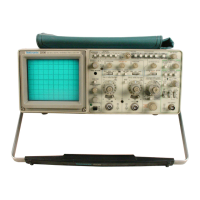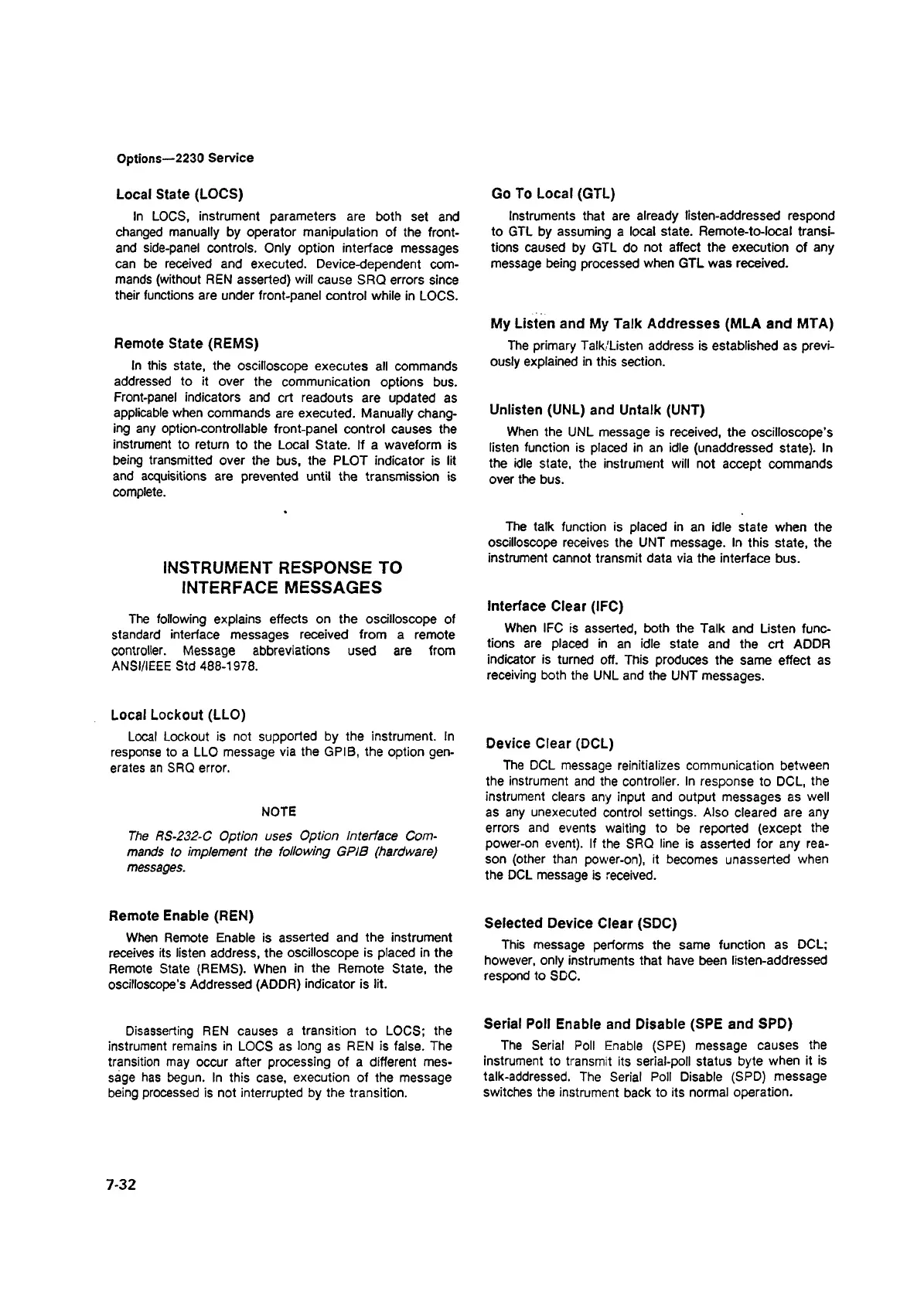Options— 2230 Service
Local State (LOCS)
In LOCS, instrument parameters are both set and
changed manually by operator manipulation of the front-
and side-panel controls. Only option interface messages
can be received and executed. Device-dependent com
mands (without REN asserted) will cause SRQ errors since
their functions are under front-panel control while in LOCS.
Remote State (REMS)
In this state, the oscilloscope executes all commands
addressed to it over the communication options bus.
Front-panel indicators and crt readouts are updated as
applicable when commands are executed. Manually chang
ing any option-controllable front-panel control causes the
instrument to return to the Local State. If a waveform is
being transmitted over the bus, the PLOT indicator is lit
and acquisitions are prevented until the transmission is
complete.
INSTRUMENT RESPONSE TO
INTERFACE MESSAGES
The following explains effects on the oscilloscope of
standard interface messages received from a remote
controller. Message abbreviations used are from
ANSI/IEEE Std 488-1978.
Local Lockout(LLO)
Local Lockout is net supported by the instrument. In
response to a LLO message via the GPIB, the option gen
erates an SRQ error.
NOTE
The RS-232-C Option uses Option interface Com
mands to implement the following GPIB (hardware)
messages.
Remote Enable (REN)
When Remote Enable is asserted and the instrument
receives its listen address, the oscilloscope is placed in the
Remote State (REMS). When in the Remote State, the
oscilloscope’s Addressed (ADDR) indicator is lit.
Disasserting REN causes a transition to LOCS; the
instrument remains in LOCS as long as REN is false. The
transition may occur after processing of a different mes
sage has begun. In this case, execution of the message
being processed is not interrupted by the transition.
Go To Local (GTL)
Instruments that are already listen-addressed respond
to GTL by assuming a local state. Remote-to-local transi
tions caused by GTL do not affect the execution of any
message being processed when GTL was received.
My Listen and My Talk Addresses (MLA and MTA)
The primary Talk/Listen address is established as previ
ously explained in this section.
Unlisten (UNL) and Untalk (UNT)
When the UNL message is received, the oscilloscope’s
listen function is placed in an idle (unaddressed state). In
the idle state, the instrument will not accept commands
over the bus.
The talk function is placed in an idle state when the
oscilloscope receives the UNT message. In this state, the
instrument cannot transmit data via the interface bus.
Interface Clear (IFC)
When IFC is asserted, both the Talk and Listen func
tions are placed in an idle state and the crt ADDR
indicator is turned off. This produces the same effect as
receiving both the UNL and the UNT messages.
Device Clear (DCL)
The DCL message reinitializes communication between
the instrument and the controller. In response to DCL, the
instrument clears any input and output messages as well
as any unexecuted control settings. Also cleared are any
errors and events waiting to be reported (except the
power-on event). If the SRQ line is asserted for any rea
son (other than power-on), it becomes unasserted when
the DCL message is received.
Selected Device Clear (SDC)
This message performs the same function as DCL;
however, only instruments that have been listen-addressed
respond to SDC.
Serial Poll Enable and Disable (SPE and SPD)
The Serial Poll Enable (SPE) message causes the
instrument to transmit its serial-poll status byte when it is
talk-addressed. The Serial Poll Disable (SPD) message
switches the instrument back to its normal operation.
7-32

